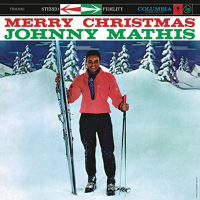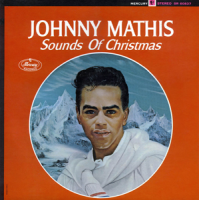Home » Jazz Articles » Book Excerpts » Misty: The Music of Johnny Mathis
Misty: The Music of Johnny Mathis
Songs for the Season: The Christmas Albums
 Every music genre deserves to be treated with respect, but that isn't always the case. Christmas music seems to incarnate both the best and worst aspects of the music industry. At its worst, it's a tactless celebration of commercialism, and at its best, it has the quality of uniting people in a timeless message of love and forgiveness. It's true that Christmas is the season of presents, but the greatest gift is the love given by God through Jesus.
Every music genre deserves to be treated with respect, but that isn't always the case. Christmas music seems to incarnate both the best and worst aspects of the music industry. At its worst, it's a tactless celebration of commercialism, and at its best, it has the quality of uniting people in a timeless message of love and forgiveness. It's true that Christmas is the season of presents, but the greatest gift is the love given by God through Jesus. Christmas is the time of love, but it's also the season of sadness. It's a time when the absence of loved ones is felt. Whether it's someone who has passed, someone who is far away, or just someone who isn't there, Christmas can be a reminder of how hard it is to be alone, and yet it is also about realizing the blessing of those who are here.
In short, Christmas tunes are songs of innocence and experience. They are songs for children and grownups, pop songs and psalms. A celebration of generosity, but also the expression of the very human desire of wanting things.
It's the great achievement of Johnny Mathis that he takes Christmas music seriously as an art form and shows how many different moods and sounds the songs can span. His love and respect for Christmas is simply a part of him, and that is also the reason why he decided to sing Christmas songs in the first place, as he has said to Michael P. Coleman, commenting on his first Christmas album: 'I come from a big family and Christmas was a big deal for us, so I decided to make a Christmas album. And lo and behold, it became a very high point in my career. I think that album and those Christmas albums that followed it are the greatest accomplishments I've ever had because I loved nothing more than having my parents listen to my music and be pleased with it. If you can imagine having a parent have people come to them and say, "Oh, it's not Christmas without your son singing a Christmas song!"—they were over the moon about it!' Merry Christmas (1958) was made with Percy Faith and his orchestra and was the first Christmas album Mathis did. Not only was it a good start, it's a masterpiece in the genre. It was also a commercial smash, perhaps his greatest success ever, certified 5X Platinum and it's still selling solidly.
The album combines traditional Christmas carols and holiday hits. The common denominator is the quality of the songs, as Mathis points out in his personal note to the album: "some of the most beautiful music I know is contained in these songs." Another asset is the superb arrangements of Percy Faith, the best he ever did with Mathis. This is Faith the sound sculptor making lush landscapes that lift the songs into tiny symphonies. Just listen to the opening "Winter Wonderland," a carousel of sweeping strings and chiming bells with Mathis 'walking in the winter wonderland.' It's Christmas magic set into music. "The Christmas Song (Chestnuts Roasting On An Open Fire)" slow things down and Mathis croons sweetly, accompanied by an operatic choir. There's a clever use of a musical quote when "Jingle Bells" turns up the second time Mathis sings that "Santa's on his way / he's loaded lots of toys and goodies on his sleigh," and the quote is repeated in the coda.
 The sound of jingling bells turns up again on the whimsical "Sleigh Ride," filled with giddy instrumental effects and Mathis playing along with charming vocal detours. On the other hand, he digs deep into balladry on the touching "Blue Christmas" and "I'll Be Home For Christmas" that both show the serious side of the season as he aches with longing, singing about coming home for Christmas, if only in a dream. The dream theme continues in a precious reading of "White Christmas." Introduced by an elegiac solo violin voice and heavenly choir, Mathis once again sings with such delicacy and feeling that lines such as "I'm dreaming of a white Christmas / With every Christmas card I write" become a poignant expression of yearning. It all ends with a Mathis signature, a prolonged vocal line, and Faith's circular string motif spiced by thoughtful use of vibraphone.
The sound of jingling bells turns up again on the whimsical "Sleigh Ride," filled with giddy instrumental effects and Mathis playing along with charming vocal detours. On the other hand, he digs deep into balladry on the touching "Blue Christmas" and "I'll Be Home For Christmas" that both show the serious side of the season as he aches with longing, singing about coming home for Christmas, if only in a dream. The dream theme continues in a precious reading of "White Christmas." Introduced by an elegiac solo violin voice and heavenly choir, Mathis once again sings with such delicacy and feeling that lines such as "I'm dreaming of a white Christmas / With every Christmas card I write" become a poignant expression of yearning. It all ends with a Mathis signature, a prolonged vocal line, and Faith's circular string motif spiced by thoughtful use of vibraphone. The arc of the album moves from secular earthly frolic and sadness to the spiritual beauty on the B-side of the album, containing the amazing 'O Holy Night,' ending almost in a whisper, "What Child is This (Greensleeves)," bathed in harp and choir, and the booming vocal proclamation of "The First Noel."
The two worlds, the secular and the spiritual, are then united on "Silver Bells" that takes the scene to the city with the sweet sound of silver bells, laughing children and shoppers rushing home. Mathis then concludes: "Christmas makes you feel emotional / It may bring parties or thoughts devotional / Whatever happens or what may be / Here is what Christmas time means to me."
On the album, Christmas is innocence, joy, sorrow, sadness, giddiness and earthly desire, but in the end, the album is wrapped up with two religious songs: "It Came Upon The Midnight Clear" where the Babel of complex human emotions is redeemed and "Silent Night, Holy Night" that announces the coming of Christ.
Merry Christmas was a hard act to follow, but somehow Mathis came up with an album that didn't disappoint at all. Part of the reason for this was that he didn't try to duplicate the sound of his Christmas debut. Instead, three of his most important collaborators were gathered to customize a leaner and lighter sound than the plush technicolor of the predecessor. Don Costa produced, the lovely arrangements were penned by Glenn Osser, and Jack Feierman conducted the orchestra and chorus. The multilayered textures were kept but expressed with fewer musical voices. In other words, if Merry Christmas was a pop symphony, then The Sounds of Christmas is closer to chamber pop.
 The approach to the choice of songs was also different this time. While the album includes some Christmas classics like "Have Yourself a Merry Little Christmas," "The Little Drummer Boy" and "Rudolph the Red-Nosed Reindeer," there is also space for some less familiar songs like "Christmas Is a Feeling in Your Heart," "A Marshmallow World" and "The Secret of Christmas." The album even includes two new songs, "Have Reindeer, Will Travel," and the title track "The Sounds of Christmas," both written by Jerry Livingston and Paul Francis Webster. Although very different, both are quality songs.
The approach to the choice of songs was also different this time. While the album includes some Christmas classics like "Have Yourself a Merry Little Christmas," "The Little Drummer Boy" and "Rudolph the Red-Nosed Reindeer," there is also space for some less familiar songs like "Christmas Is a Feeling in Your Heart," "A Marshmallow World" and "The Secret of Christmas." The album even includes two new songs, "Have Reindeer, Will Travel," and the title track "The Sounds of Christmas," both written by Jerry Livingston and Paul Francis Webster. Although very different, both are quality songs. "The Sounds of Christmas" brilliantly uses the conceit of hearing in a string of virtuoso variations in the lyrics: "Snap and crackle of the yuletide log / Popcorn popping in the grate / Neighbors knocking at the old front door / Drop in to help celebrate / The sounds of children / Laughing sounds of girls and boys / Playing with their Christmas toys / Silver bells that jingle on the tree." These musical scenes of sound could be justified as a mood painting in itself, but like a Shakespearean sonnet, there's a volta that adds a surprising twist and turns the song into an elevated expression of romantic love: "But of all the sounds of Christmas / No sweeter sound could be / Than the Merry Christmas kissеs that my love gave me."
Musically, the song is just as clever, ending with a quotation of "Deck the Halls." The play with words and music continues on "Have Reindeer, Will Travel" that humorously describes the ride in Santa's sleigh while acknowledging the heritage of Johnny Mark's iconic "Rudolph the Red-Nosed Reindeer," once again referencing the names of the reindeers.
The religious songs don't take up as much space this time, but "Hallelujah Chorus" from George Frideric Handel's Christmas Oratorio, Messiah, concludes the album, and the song is highlighted by Mathis along with 'The Carol of the Bells' in his notes for The Complete Global Albums Collection: 'For this album, I decided to record the 'Hallelujah Chorus' and the 'Carol of the Bells'—I just sang my part, the part that all the tenors sing in these particular compositions. I had no problem about doing it, my only concern was how I would get my voice to be predominant if I sang only one part of the melody. You know, when you're young, nothing frightens you. The fact that I had sung these songs in school for years, with all kinds of choirs, I thought, why not, let's do it. And as the years went on, people got used to hearing those songs at Christmas time.' Indeed, people like hearing Mathis singing Christmas songs, then and now. The album spent two weeks on Billboard's Christmas Albums sales chart, a chart that was established in 1963. The following years, it would show up on Billboard's seasonal LP chart and today, it deserves the status of a Christmas classic, not quite up there with Merry Christmas, but close.
Tags
Book Excerpts
Johnny Mathis
Jakob Baekgaard
Misty: The Music of Johnny Mathis
Christmas albums
Merry Christmas
The Sounds of Christmas
PREVIOUS / NEXT
Support All About Jazz
 All About Jazz has been a pillar of jazz since 1995, championing it as an art form and, more importantly, supporting the musicians who make it. Our enduring commitment has made "AAJ" one of the most culturally important websites of its kind, read by hundreds of thousands of fans, musicians and industry figures every month.
All About Jazz has been a pillar of jazz since 1995, championing it as an art form and, more importantly, supporting the musicians who make it. Our enduring commitment has made "AAJ" one of the most culturally important websites of its kind, read by hundreds of thousands of fans, musicians and industry figures every month.





















